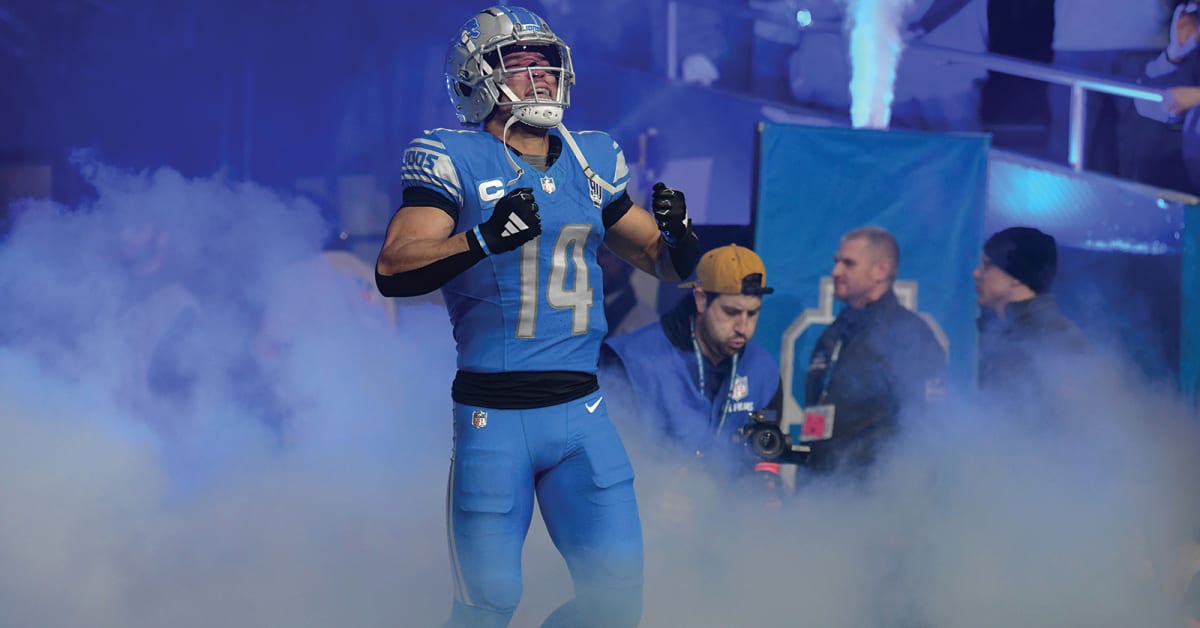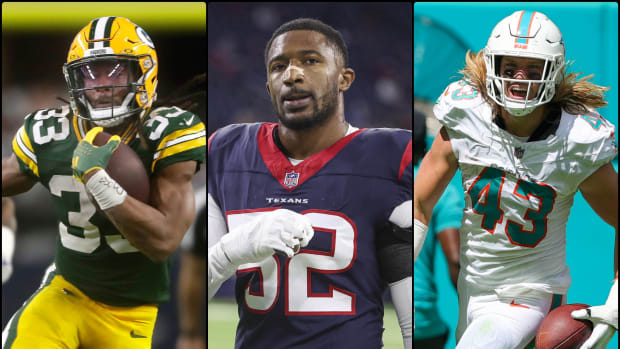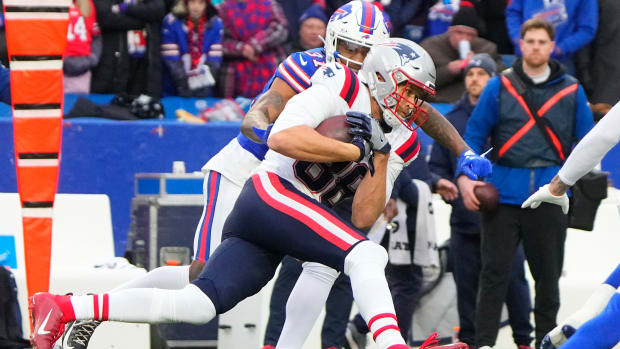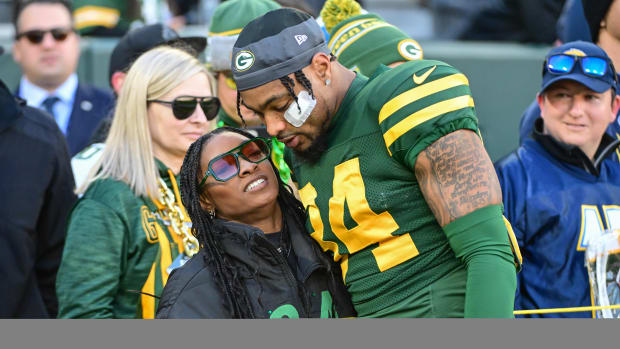Amon-Ra St. Brown Is Creating a New Universe for the Lions
The receiver strolls onto his team’s empty turf practice field, where banners hanging on the far wall unfurl like oversized, ancient scrolls. Each features the same two words: NFL CHAMPIONS. But look closer, lower, at the dates: 1935, ’52, ’53 and ’57, followed by a final poster that announces a division title in … 2023.
The story of the Detroit Lions is laid out in those five billboard-sized squares: their success in professional football is vintage and archaic; their misery endless and established; but their present (finally! mercifully!) more fruitful than at any other point in, oh, say, the last 67 years.
His head provides the most colorful kind of proof. Amon-Ra St. Brown made a promise before this season started, vowing to dye his dome if the Lions made the playoffs. When they did, he called a salon in nearby Birmingham where many wives of Detroit players get their hair done. The process took three hours, morphing from black to bleach blonde to blue—bright, blinding, Smurfs-approved blue.
In fact, on this Friday in mid-January, with kickoff for a divisional round home playoff game against the Tampa Bay Buccaneers less than 48 hours away, St. Brown has just completed a FaceTime call with a Lions fan who’s in hospice care. The fan took the same, ahem, route as Detroit’s catalyst, deciding to go full Marge Simpson or Cardi B. A signed jersey was in the mail, after two strangers with little in common fast became brothers in blue.
St. Brown makes that kind of impact—on his teammates, his franchise and a city of long-suffering NFL fans who can watch him catch passes and score touchdowns and see, in him, a little bit of themselves. Overlooked. Underappreciated. But ready, regardless, to keep rising, keep trying; a resilience sure to be rewarded.
In most ways, he’s not like them at all. His father, John Brown, was Mr. Universe—yes, that Mr. Universe (and Mr. World and Mr. Olympia)—not long after Arnold Schwarzenegger. His mother, Miriam, enrolled Amon-Ra in French grammar school and only speaks to him in German, even now. They named the youngest of their three boys after Amun, the chief god of ancient Thebes, the single most important deity in the Egyptian pantheon. Amid a few centuries spent god-ing in obscurity, Amun first meant “The Hidden One.” But then he merged with an ancient and prestigious sun god, one Re of Heliopolis. Together, they became Amun-Re, master of monikers, whether “King of the Gods,” “Lord of Heaven” or “Lord of the Thrones of the Two Lands.”
This composite god of multiple nicknames, obscure no longer, assumed two humanlike forms. In both, his skin was sometimes depicted as red and sometimes shown as black. But most typically, as Amun-Re led Egypt into what’s called the New Kingdom period, his other, more typical skin color symbolized abundant fertility borne from an abundance of rich soil nearby. Stretch that ancient history far enough—the universe, the hidden one, rich soil, the new kingdom—and that’s the Lions, this season, behind a wideout who doubles as the soul of a franchise that’s amid a remarkable transformation. Just like him.
Amun-Re’s more typically depicted skin color? Blue, naturally.
The singular play that now defines this most special of Lions seasons had happened five days earlier, late in the fourth quarter of a wild-card playoff game, with Detroit clinging to a one-point lead over the surging Los Angeles Rams. Quarterback Jared Goff, a former Ram dumped unceremoniously on Detroit three years earlier, took the snap in shotgun, saw St. Brown in single coverage on a 10-yard curl route and fired a pass between defenders. St. Brown caught it for an 11-yard gain.
Inside the field house, St. Brown is trying to describe the play as just like any other, a workmanlike grab for a blue-collar wideout who earned every inch of his scenic route to stardom. The catch meant another game with at least 100 receiving yards, his 10th in the 2023 season alone. But he also knows there wasn’t anything typical about it. It marked the precise moment where 32 years of pro football misery ended, after three decades worth of seasons that all featured the same ending, not a single postseason victory among them, despite Matthew Stafford and Megatron and Barry freaking Sanders.
Detroit’s new Lord of the Thrones of the Two Lands (or whatever) had delivered, once more, registering his team’s highest grade (90.7), per Pro Football Focus, in the franchise’s most important game this century. His 315 career receptions rank as the third-most in NFL history by any player in their first three seasons, behind only Justin Jefferson and Michael Thomas (and not by much).
St. Brown might be the most serious player in the NFL, a superstar engineered in a parenting laboratory of sorts; so serious, even as a child, that his parents say he never played with toys. St. Brown knew what he wanted, where he was headed. They ensured he would become more than an athlete, but football fields were where he emoted, prancing and dancing, picking fights. Gridirons were where he came alive, his truest form of self-expression.
Every coach who ever scribbled on a white board will drone on endlessly about culture—creating, imprinting, solidifying, broadening. But only coaches with rare players like St. Brown, the elite among the elite, naturally gifted and intrinsically motivated, can imprint each stage through no more than clocking in for work.
Speaking of, the first time St. Brown practiced with the Lions, he beckoned the player he believed was the “baddest dude” on defense, his father says. St. Brown promptly started a fight with Jeff Okuda, a top five NFL draft pick. The quality of the skirmish didn’t matter; the message starting it sent did. As St. Brown stalked away from the scrum, he shouted, “Let’s do that again!”
The youngest of three St. Brown brothers always approached his craft this way. As an eighth grader, he attended a skills camp for elite college prospects in Los Angeles. Jim Harbaugh was in attendance. So was Urban Meyer. Same thing. Amon-Ra kept barking at the defense, beckoning the cornerback who might declare himself the best among them for a showdown. The kid who raised his hand couldn’t cover St. Brown and, instead, grabbed onto his shorts as he came out of his break. This sent St. Brown into a rage. He yelled and stomped and screamed, wanting to succeed that badly, that daringly and that publicly, until Meyer placed a hand on his chest to calm him.
St. Brown took exactly one play off. Then he sauntered back to the front of the line, cutting the other prospects, signaling for the same cornerback. This time, St. Brown wiggled open; this time, same as most times, St. Brown won. “The boy threw the ball at him,” his father says. “[Amon-Ra] just went crazy. The boy had no fear. No fear whatsoever.”
Consider this season just the latest example of that ethos his parents laid out over breakfast on Friday at a café in Birmingham on another frigid, snow-blanketed morning in suburban Michigan. Yes, their youngest was grossly snubbed in Pro Bowl voting. But he earned the honor that matters more; his peers voted him first-team All Pro. In some ways, the parents Brown find the last 12 months surreal. In most others, they view it more as, well, what everyone in the family expected all along.
“I’ve gone all night, laying in my bed, looking at the picture [of the first-team All-Pros],” John Brown says. “His face is on there. That’s my little baby.” The boy he prepped for this, all of this, exactly this. How does a franchise upend three decades of football futility? Start with finding that guy, that dude, King of the Gods, him.
At the worldly house where Mr. and Mrs. Universe raised three football stars to speak fluent German and lift weights before their teens, the celebration never really started. Sure, something like 60 relatives and friends of St. Brown showed up in late April 2021, to revel and rejoice and be there, on the first night of the NFL draft or the second, when a family of overachievers sent another son into professional football.
Hours vanished instead inside a contradiction, the longest blur; pick after pick, gone, poof. The mood dimmed, then darkened, then, somehow, got worse. St. Brown stewed, disbelief hardening into anger, anger threatening to unleash that rage. After two days of drafting and three rounds completed, John Brown found his youngest, looked him in the eyes and said “get out of here.”
As always, St. Brown listened to his father, but not before taking a spin around the house to thank everyone who showed up for the party that would never be. He cried as he climbed into his car and cried as he drove away, the car pointed toward the home he shared with his brothers in Newport Beach. He can’t remember if he played any music on the drive. He can recall stopping for gas. “Just shocked,” he says. “I mean, speechless, hot, pissed.” Would he get drafted on Day 3? Did it even matter?
Still, around midnight, he did what St. Browns do. He went to a football field with his brothers, loaded up a JUGS machine and snagged passes until his hands hurt. He slept. Woke up. Drove back to his parents’ house, where the party had dwindled to about 10 people. He sat on the same couch, in the same spot, and forced himself to watch until the Lions ended his agony, in the fourth round, at pick No. 112. St. Brown didn’t just make a list of the 16 receivers taken before him; he memorized their names and compared résumés, layering motivation on top of motivation. But this story, while telling, isn’t always framed correctly.
The important part isn’t the slights, the slide, or even The List. The important part is not where he didn’t go but where he did end up; not what happened but what could, might, will. In order for Detroit, an NFL doormat for so long that footprints are all but stamped onto Lions jerseys, to contend for Super Bowl LVIII next month and championships in future seasons, it needed a catalyst.
The kind of player, in other words, who could shape not a team but its soul. Who was built to respond not to this specific situation but to any situation. Who could stare down a three-decade-plus drought since a franchise’s last playoff victory and expect to be among those who put an end to 32 years of postseason misery. And then to see that accomplishment for what it was, which is not an end of any sort but the beginning of much, much more.
His parents, Amon-Ra explains, were tough on all three boys. He’s more explaining than complaining, pointing toward where his serious nature started. Unlike classmates, he hardly ever went out; his focus, always, centered on schoolwork and football. He never wanted to be the best receiver in his city, or his state, or in his conference. Even at USC, the program his father believes St. Brown should have transferred out of, the goal wasn’t to become the top wideout in college football, even.
Even when no one else saw what he saw, St. Brown aimed at the highest possible targets. His goal, for years now, has been to stake his claim as the best receiver in the NFL. This season, he added to his argument. St. Brown’s 119 catches tied for second-most in the league (behind CeeDee Lamb). His 1,515 receiving yards ranked third (behind Lamb and Tyreek Hill in both, but with far fewer targets). His 10 touchdown catches tied for fourth (behind those two and Mike Evans … not to mention teammate Sam LaPorta, who also scored 10 TDs).
This season, St. Brown says, he felt “free.” Free to have fun, loosen up and unleash touchdown dances that highlight his athleticism. “Sundays are the day that me comes out,” he says.
These Lions, the streak busters, rely on a coach in Dan Campbell for whom “colorful” only begins to describe. They do burpees—for fun. They compete after practice, in their locker room, in pool, table tennis and dominoes. They laud Goff’s resurgence, marvel at Aidan Hutchinson’s immense talent and feature no shortage of skill or speed. But make no mistake. The Lions’ new kingdom is ruled by the receiver with blue hair.
The King of the Gods can do pretty much anything. His college position coach, Keary Colbert, marveled at St. Brown’s short-area quickness, the way he shot forward after snaps, as if running on fast forward. How was the same kid also one of the strongest Trojans; an elite, willing blocker unafraid to mash defensive backs? How was that guy, the quick one, the strong one, the desperate one, also one of USC’s hardest workers?
Built different, that’s how. Which is how a young wideout, drafted in the fourth round, becomes a team captain. Listen to John Brown explain it and this—the football family, Amon-Ra’s greatness, this Lions season—all comes down to throwing knives. Because of course it does. Besides those Mr. Universe titles, John comes up with so many philosophical musings he’s sort of a human fortune cookie. John-isms, his friends call these. And, with the whole throwing knives sentiment, he means that driven humans, like his sons, spend half their lives toiling to make sure that when someone they care about is on some sort of spinning wheel of death, and they alone grip the knife that must be thrown toward said wheel in their hands, they must be confident and decisive. Or something like that.
He prepared his sons to throw some knives. Amon-Ra’s catch to seal that elusive playoff victory was a knife perfectly thrown at the wheel that is this season. Stay with Mr. Universe here; the nickname, after all, projects such cosmic turns in conversation. He created a blueprint to do for his boys what he believed his father should have done for him—give answers, build resilience, show them what’s possible, if they listen, if they work.
“In terms of sports, it’s all about the knives,” he says, while Miriam appears to smile a small smile and roll her eyes. (And that’s before John argues that future parents should decide what endeavors they want their kids to excel at, then practice “selective breeding” in finding a mate. “Your daughter can fall in love with the guy who’s dressed up as the cookie man in the mall,” he says, and, somehow, as typically happens in the Tao of Brown, this explanation makes perfect sense.)
In other words, he bred selectively—his words—developed a parenting methodology, applied said approach to each of his three boys and then watched as each threw knives the way that Goff slung touchdown passes all season. Proof came in the form of the hair, the name, the season and The Catch—each, one might say, a sign from Mr. Universe, Mrs. Universe or the universe. Doesn’t matter, really. When universes speak, St. Browns, they listen.








































